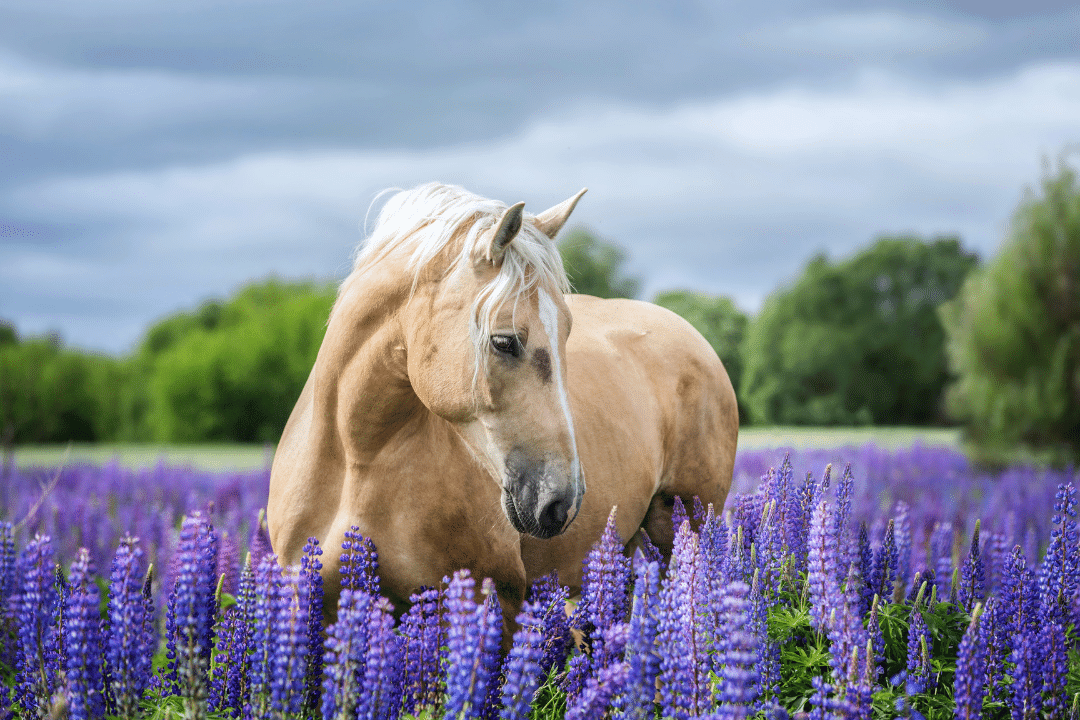
03 Apr 2021 Basics of Feeding – The Digestive System
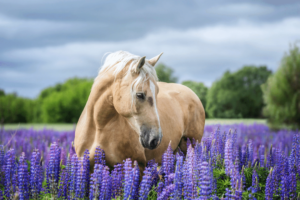 The Basics
The Basics
Digestion means turning food into fuel. There are a number of elements EVERY horse should have in their diet. Here’s the most simple breakdown of equine nutrition out there.
Forage
All diets should start with forage (grasses and hays.) 1.5 to 3% of the horse’s body weight should be available through forage on a daily basis. (Depending on the energy requirements, determined by workload, environment, stress etc.) A good average is 2% of BW. For a 1OOO lb. horse (5OO kg), that means about 2O lb. (1O kg) of hay.
Water
Clean, fresh water needs to be available at all times. In very cold weather, water should be temperature controlled and snow is NO substitute!
Salt
Sodium and chloride are essential for many bodily functions of the horse and are needed on a daily basis.
Other Elements
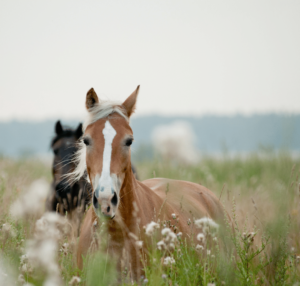 Depending on your horse’s lifestyle, workload and health situation, one may need to consider adding other feedstuffs such as:
Depending on your horse’s lifestyle, workload and health situation, one may need to consider adding other feedstuffs such as:
Concentrates, Bagged Feed, Grains
Not high in fiber, but high in calories from non-structural carbs (sugar and starch), protein or fat (usually bagged pre-mixed feed from feed store.)
Fiber
Added digestible fiber, adding calories without sugar and starch, such as beet pulp, bran, hulls of grains.
Legumes
Protein from leafy greens, usually alfalfa in the form of hay, cubes or pellets. High quality protein is essential for the production of body tissues.
Supplements
To fill in nutrient gaps, support medical needs or disorders, support with injuries etc. Multiple supplements need to be cross-checked for overlapping ingredients that could combine to be too much for horses or detrimental in high doses.
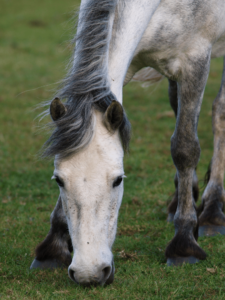 Does my Horse Need all that Stuff?
Does my Horse Need all that Stuff?
Many horses can get by with just forage. However, when hay is the main form of forage, it may be necessary to add some more calories or other sources of vitamins and minerals to the diet as the quality of hay deteriorates with age (fresh cut is always best). The drying and storing of fresh grass leads to a loss of certain nutrients and can make various supplements becomes necessary.
The most common nutrients that need to be added in are Vitamin E, Essential Fatty Acids and Minerals.
The Digestive System of the Horse
The digestive tract of a horse is different from that of most other animals and humans. They are ‘non-ruminant herbivores’. This means that they only eat plants (herbivore) and they lack the multiple stomachs, which characterize ruminant herbivores such as cows, goats, sheep and deer.
They have the ability to digest plant material, such as cellulose and break it down into small molecules of simple sugar (glucose) which is then absorbed from the digestive system into the bloodstream and taken to the animal’s cells to be metabolized for calories that allow the nervous system to work, the heart to beat and to provide energy for exercise, body heat and breathing.
The majority of the digestion however does not happen in the stomach, but the intestines and cecum. It contains millions of digesting bacteria but is not as efficient a system as ruminants, so horses need to consume much greater amounts of forages to get the same number of calories than cows or goats do.
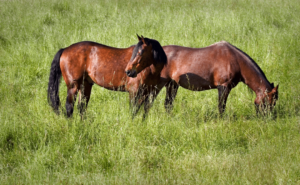 What is Natural?
What is Natural?
In a natural setting, horses will graze just about all day with small rest times in between to nap or play. Horses are designed to rely on their speed, agility, and caution to preserve themselves from predators. While grazing they can survey the area (their thin legs and long nose, with eyes higher off the ground help reduce blind spots) but they have to be prepared to run at any time at high speed.
They ‘trickle feed’ and rest while standing and to accommodate this digestion method, they have a large fermentation chamber that works slowly but steadily and does not inhibit the horse from moving suddenly at top speed to safe itself from danger.
Restriction from movement (example, stalls) and long periods of fasting is absolutely unnatural to the horse and is a massive contributing factor to many serious health issues. The more naturally you can keep your horse’s lifestyle and diet, the healthier, longer life they will have.
Important Stomach Acids
Horses do not have a gall bladder, which control and release stomach acids only when there is food present, but produces acid continuously. If these acids are not being used for digestion, the excess can burn and irritate the stomach lining, causing ulcers, diarrhea, behavioral problems due to pain, and even colic.
Having a little bit of food in their stomachs at all times acts as a buffer for this acid, and keeps your horse away from painful conditions. Saliva is one of your horse’s most powerful resources. It is a natural anti-acid produced by chewing, so it is essential they are able to do so at all times.
Worried that if you provide free-choice hay or unlimited grazing time that your horse will gorge themselves or become sick? Fear not. Horses are not like dogs and show in studies that horses are able to naturally self-regulate their food intake.
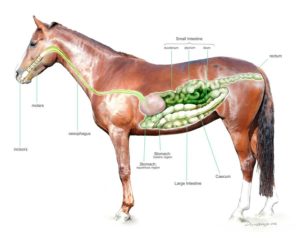 The Digestive System – A Closer Look
The Digestive System – A Closer Look
From the moment you offer your horse something to eat, the following process takes place:
1. The horse will start chewing and at the same time start producing saliva to moisten the food, which makes it easier to swallow. Saliva contains two important substances: bicarbonate, to neutralize the stomach acid, and amylase, which starts breaking down the starches in food.
2. The swallowed food will travel down the esophagus and through the esophageal sphincter, a circular muscle at the bottom, just before the stomach. The sphincter will allow food to go to the stomach and then close tightly to not let food return. Horses cannot vomit, but as herbivores, they should not need to.
3. The food is then in the stomach, which is small compared to the size of a horse and the rest of the digestive system. This is because horses are designed to eat small amounts of forage continually without filling up the stomach. If the stomach is filled with large portions of feed, it can lead to rupturing, colic, and inadequate digestion of carbohydrates, which can then lead to laminitis.
Important! It is crucial to WEIGH any bagged feed/grain that you feed your horse and not measure based on “scoops” or volume. Nutrition is a science and accuracy is key.
4. Once in the stomach, the food is mixed with acid and pulverized by very strong stomach muscles. The acid will start protein digestion with the help of an enzyme called pepsin. It will then loosen the bonds between amino acids making the protein digestion easier and finally it will destroy microorganisms the horse consumes by eating off the ground. Stomach acid is essential to the health of the horse. Frequently used, or long term medications like ulcer treatments and pain relief can disrupt their immune system.
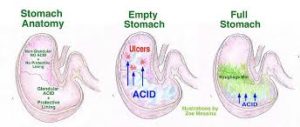 The stomach of the horse is broken into two parts: the lining of the upper portion of the stomach is made of non-glandular, squamous cell layer that is vulnerable to the acid in the stomach. But, if there is enough food in the stomach, that will form a “food mat” which serves to absorb this acid to avoid ‘splashing’ acid onto this upper layer. Hay will absorb 4 times its weight with moisture. It is in this upper layer that most ulcers are found. The bottom part of the stomach is more resistant to stomach acid but is not impervious to issues.
The stomach of the horse is broken into two parts: the lining of the upper portion of the stomach is made of non-glandular, squamous cell layer that is vulnerable to the acid in the stomach. But, if there is enough food in the stomach, that will form a “food mat” which serves to absorb this acid to avoid ‘splashing’ acid onto this upper layer. Hay will absorb 4 times its weight with moisture. It is in this upper layer that most ulcers are found. The bottom part of the stomach is more resistant to stomach acid but is not impervious to issues.
5. This mixture of acid and food with pepsin then continues very soon (after only about 15 minutes) through the digestive tract and exits the stomach to enter the small intestine.
6. The small intestine produces enzymes to digest protein, fats and carbohydrates such as sugar and starch (the non-structural carbohydrates). Fiber (another form of carbohydrate) however, can not be digested in the small intestine.
Digestion will result in molecules small enough to be absorbed into the bloodstream (amino acids from protein, fatty acids from fat and glucose from sugars and starches) to be transported to the tissues that need them. There they are either stored, used for energy or used as building blocks for body tissue (muscle, enzymes, hair, skin, hooves, etc…)
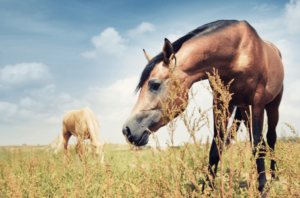 When non-structural carbohydrates are digested, blood glucose levels increase and trigger the pancreas to produce insulin. Insulin allows glucose to leave the blood and to enter the cells, where it can be metabolized for energy. Too much starch and sugar will lead to large glucose fluctuations, which can lead to behavioral problems and unpredictability in some horses. Think of a sugar high and the following crash in children.
When non-structural carbohydrates are digested, blood glucose levels increase and trigger the pancreas to produce insulin. Insulin allows glucose to leave the blood and to enter the cells, where it can be metabolized for energy. Too much starch and sugar will lead to large glucose fluctuations, which can lead to behavioral problems and unpredictability in some horses. Think of a sugar high and the following crash in children.
In other cases, the horse can be insulin resistant and insulin levels will rise above normal levels because it is not able to remove the glucose effectively from the bloodstream. (Metabolic syndrome and Laminitis.)
Overload of sugar and starch will also overwhelm the small intestine and the undigested portion will overflow into the hindgut, which is not designed to digest it. There, it will be fermented by bacteria and can lead to Laminitis. When sugars and starches are digested in the hind gut, lactic acid is produced, which reduces the pH (acidity) of the hindgut (hindgut acidosis) and kills the good microbes needed for the digestion of fiber.
7. The Cecum is the next area in the digestive tract and this is where the fibrous components of feed (hay, pasture, seed hulls…) are digested. It relatively large fermentation vat, which contains most of the live microbes that produce enzymes, which can break down fibrous materials into volatile fatty acids.
Microbes in the cecum are also responsible for the production of vitamin K and B vitamins (including biotin and folic acid), which have varying functions.
8. The last area is the small and large colon (together with cecum forming the hindgut) or large intestine.
The main function of the large intestine is to absorb vitamins, volatile fatty acids, minerals and water into the bloodstream.
The remainders are fecal waste, which enters the rectum and is excreted.
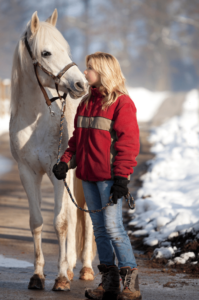 Summary
Summary
The horse’s digestive system is complex and it’s easy for things to go wrong even with good intentions.
Nutrition is a science and professional equine nutritionists like me are here to help you and your horse avoid major health issues down the road, fix behavioral and lifestyle issues, and help you and your horse live a harmonious, joyful life together.
I’ve seen all kinds of changes in my own horses and in my clients’ horses. Some of them were so amazed at how much happier their horses were that they wanted to share their Testimonials.
If you’re wondering about how to go about your horse’s nutrition plan the right way, I give a FREE diet strategy phone call to anyone who wants help with problems or answers to questions.
I’m here to help guide you through your horse’s nutrition needs so please connect with me if you’re concerned about your horse!
Further Reading
Nutrient requirements of Horses, sixth revised edition, 2007. Washington, D.C. National Research Council, National Academy Press
Frape, David, Equine Nutrition and Feeding, fourth edition, 2010, John Wiley & Sons, Chichester, West Sussex, UK
McGreevy, Paul, Equine Behavior, 2010, Elsevier, New York, NY, USA
Briggs, Karen, Understanding Equine Nutrition, 2007, Blood-Horse publications, Lexington, KY, USA